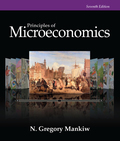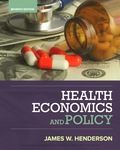
Example of adverse selection.
Answer to Problem 1CQQ
Option ‘b’ is the correct answer.
Explanation of Solution
Option (b):
Elaine, the buyer of health insurance knows more about her own health problems than the insurance company. The
Option (a):
Inspite of getting a health insurance, Elaine is not imperiling herself to illness. Hence, option ‘a’ is incorrect.
Option (c):
Health insurance does not signal the health issues of a person. Hence, option ‘c’ is incorrect.
Option (d):
The insurance company is not asking the parties for their health information. Hence, option ‘d’ is incorrect.
Concept introduction:
Adverse selection: Adverse selection refers to a situation where there is a lack of information existing in the market before the economic transaction takes place, thereby resulting in an undesired outcome.
Moral hazard: Moral hazard refers to changes in the behavior of people after they have entered into a transaction that makes the other party in the transaction worse off.
Signaling: Signaling is an action taken by an informed party to reveal private information to an uninformed party.
Screening: Screening refers to the action of one party in the process of finding the required skill and information of other party.
Want to see more full solutions like this?
Chapter 22 Solutions
EBK PRINCIPLES OF MICROECONOMICS
- Published in 1980, the book Free to Choose discusses how economists Milton Friedman and Rose Friedman proposed a one-sided view of the benefits of a voucher system. However, there are other economists who disagree about the potential effects of a voucher system.arrow_forwardThe following diagram illustrates the demand and marginal revenue curves facing a monopoly in an industry with no economies or diseconomies of scale. In the short and long run, MC = ATC. a. Calculate the values of profit, consumer surplus, and deadweight loss, and illustrate these on the graph. b. Repeat the calculations in part a, but now assume the monopoly is able to practice perfect price discrimination.arrow_forwardThe projects under the 'Build, Build, Build' program: how these projects improve connectivity and ease of doing business in the Philippines?arrow_forward
- Critically analyse the five (5) characteristics of Ubuntu and provide examples of how they apply to the National Health Insurance (NHI) in South Africa.arrow_forwardCritically analyse the five (5) characteristics of Ubuntu and provide examples of how they apply to the National Health Insurance (NHI) in South Africa.arrow_forwardOutline the nine (9) consumer rights as specified in the Consumer Rights Act in South Africa.arrow_forward

 Principles of Economics 2eEconomicsISBN:9781947172364Author:Steven A. Greenlaw; David ShapiroPublisher:OpenStax
Principles of Economics 2eEconomicsISBN:9781947172364Author:Steven A. Greenlaw; David ShapiroPublisher:OpenStax Exploring EconomicsEconomicsISBN:9781544336329Author:Robert L. SextonPublisher:SAGE Publications, Inc
Exploring EconomicsEconomicsISBN:9781544336329Author:Robert L. SextonPublisher:SAGE Publications, Inc Economics (MindTap Course List)EconomicsISBN:9781337617383Author:Roger A. ArnoldPublisher:Cengage Learning
Economics (MindTap Course List)EconomicsISBN:9781337617383Author:Roger A. ArnoldPublisher:Cengage Learning
 Managerial Economics: A Problem Solving ApproachEconomicsISBN:9781337106665Author:Luke M. Froeb, Brian T. McCann, Michael R. Ward, Mike ShorPublisher:Cengage Learning
Managerial Economics: A Problem Solving ApproachEconomicsISBN:9781337106665Author:Luke M. Froeb, Brian T. McCann, Michael R. Ward, Mike ShorPublisher:Cengage Learning





